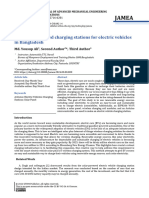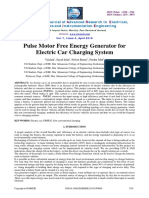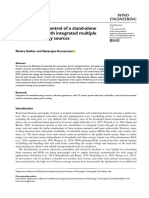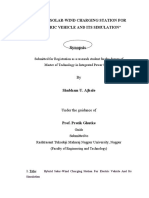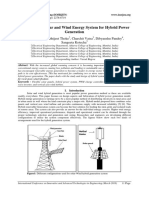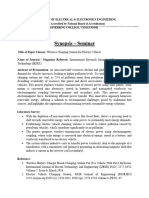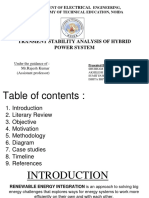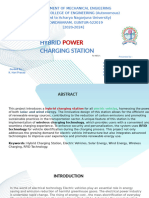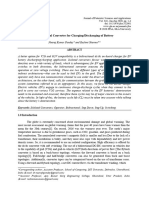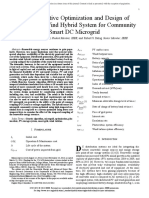Solar
Solar
Uploaded by
116-Sravan KumarCopyright:
Available Formats
Solar
Solar
Uploaded by
116-Sravan KumarCopyright
Available Formats
Share this document
Did you find this document useful?
Is this content inappropriate?
Copyright:
Available Formats
Solar
Solar
Uploaded by
116-Sravan KumarCopyright:
Available Formats
See discussions, stats, and author profiles for this publication at: https://www.researchgate.
net/publication/323187231
Solar and Wind Energy based charging station for Electric Vehicles
Article · January 2018
CITATIONS READS
9 9,440
1 author:
Muthammal R.
SAVEETHA ENGINEERING COLLEGE
20 PUBLICATIONS 45 CITATIONS
SEE PROFILE
All content following this page was uploaded by Muthammal R. on 13 April 2018.
The user has requested enhancement of the downloaded file.
ISSN (Print) : 2320 – 3765
ISSN (Online): 2278 – 8875
International Journal of Advanced Research in Electrical,
Electronics and Instrumentation Engineering
(A High Impact Factor, Monthly, Peer Reviewed Journal)
Website: www.ijareeie.com
Vol. 7, Issue 1, January 2018
Solar and Wind Energy Based Charging
Station for Electric Vehicles
C. Chellaswamy1, V. Nagaraju2, R. Muthammal3
Professor, Department of ECE, Rajalakshmi Institute of Technology, Chennai, Tamilnadu, India1,2
Professor, Department of ECE, Saveetha Engineering College, Chennai, Tamilnadu, India3
ABSTRACT: This paper describes the solar and wind energy based charging mechanism (SWCM) to generate the
power for charging the battery packs of electric vehicles (EVs). The renewable charging station consists of both the
solar photovoltaic (PV) modules and a wind generator. The SWCM immensely reduce the requirement of fossil fuels to
generate electricity which results in greatly reduced CO2 and CO related emissions. The renewable sources such as
wind and solar has been modelled using single diode model and an analytical modelling has been done for wind energy
generation. The simulation model has been developed in MATLAB-Simulink for the proposed SWCM. The I-V and P-
V characteristics of the solar panel have been studied under various irradiance levels and different parameters of wind
turbine has been studied under two different loading (1 kW and 3 kW) conditions. There are two unidirectional direct
current (DC) to DC converters are connected to the PV modules and the wind turbine and six bidirectional DC-DC
converters are connected to ten charging points which provides charging to the electric vehicle. To balance the load
demand, the proposed system is connected to the grid through a three phase bidirectional DC-AC (alternating current)
inverter. The obtained results show that the proposed renewable charging mechanism is suitable for EV charging thus
creating pollution free environment.
KEYWORDS: Electric Vehicles, Synchronous Generator, Recharging Mechanism, Solar Energy, Wind Energy.
I.INTRODUCTION
Since electric vehicles have been utilized in the 1990s, their dispersion into the vehicle market has not been up to the
mark because of the reason that it is less cost effective and these vehicles need to recharge once in 60 to 70 km drive.
The hybrid vehicles play a major role in the present market and it obtains their energy from the combustion engine.
However, in order to alleviate the utilization of gasoline, the plug-in electric vehicles (PHEVs) entered into the market
and it takes the energy from the grid for driving. To increase the life of storage system, cost reduction, and the flexible
grid connectivity, the PHEVs are still under research.
Nowadays, the park stations, roadside units, and the standard home outlets are used to charge the battery packs of EVs.
The storage system present in the EV takes a prolonged period for recharging the battery packs and it will vary
depending upon the capacity. A new charging method is introduced by Chellaswamy et al. for recharging the EVs. The
control system present in this mechanism automatically charges the battery packs without the contribution of the driver.
The performance analysis has been done and the result is compared with other EVs [1]. The plug-in EVs are used to
reduce the green house gas emissions. The high-frequency ac-dc converter is used to charge the traction battery packs
and an electromagnetic interference (EMI) filter is connected with the high-frequency transformer to suppress the EMI
noise has been studied in [2]. A high sampling rate camera with a sensor is used to estimate the slip angle measurement
of EV. The performance of this model based estimator has been studied by Yafei et al. with the help of multi-rate
Kalman filtering [3]. A linear programming is used to estimate the operating cost, optimal scheduling, and CO2
emission of a hybrid EV under European regulation. This mechanism also controls the electricity consumption of EVs
[4]. A control algorithm has been developed to equally maintain the state of charge (SOC) of all the NiMH battery
packs which are present in the EVs. The SOC variation for different temperature and the percentage of improvement
has been studied by Man et al [5, 6]. To limit the rate of charge and the cost a smart algorithm has been developed and
the performance is studied by Mosaddek et al. An experimental setup has been implemented and electrifying the plug-
Copyright to IJAREEIE DOI:10.15662/IJAREEIE.2018.0701006 313
ISSN (Print) : 2320 – 3765
ISSN (Online): 2278 – 8875
International Journal of Advanced Research in Electrical,
Electronics and Instrumentation Engineering
(A High Impact Factor, Monthly, Peer Reviewed Journal)
Website: www.ijareeie.com
Vol. 7, Issue 1, January 2018
in EVs by parking garage standard outlet. A comparative analysis has been performed for SOC under different
temperature conditions [7].
Hybrid renewable energy (RE) based power generation become popular because of anxiety over the atmosphere. To
eliminate the transmission loss and grid connectivity problems, RE based power generation is carried out in [8]. The
wind power generation system has a less harmful impact compared to fossil fuels. The wind energy potential and
electricity generation for recharging the storage system present in the EV has been studied in [9, 10]. Among different
wind generators, the permanent magnet synchronous generator (PMSG) is more popular because of its generation
capacity. The power quality is improved by Geng and Xu with the support of power electronics [11]. The maximum
power tracking and control system has been introduced for increasing the amount of power generation of the wind
turbine has been studied in [12]. The possibilities of providing electricity through a renewable hybrid energy system to
a remotely located community, Bekele and Palm [13] and a renewable source for recharging the EV is discussed by
Chellaswamy and Ramesh [14]. The hybrid energy system is a better alternative for pollution free atmosphere. This
type of energy system is implemented in a region Hurghada in Egypt for reverse osmosis desalination is carried out by
Fahmy et al. [15]. For minimizing the life cost, Hafez and Bhattacharya [16] proposed an optimal design of a hybrid
energy system which includes PV, wind and a micro-hydro for generating power. To predict the exact behavior of PV
panel by simulation, developing a suitable model is necessary [17, 18]. The single and double diode models have been
familiarly used to extract the solar cell parameters has been studied [19, 20].
Different recharging stations for EVs and its analysis has been explained in [21, 22]. Variability in the PV produces
major drawback of EV charging and it can be solved by using smart charging system. The smart charging has different
benefits such as reduce the peak demand on grid and increasing the generation of PV [23]. The maximum PV
utilization occurs when the charging profile of the EV has been varied with time [24] and the surplus amount of energy
can be reduced by increasing the number of EVs [25]. On the other hand, the charging is done using a constant power
EVs leads to follow the generated power of PV [26]. The wind energy conversion system consists of three important
parts such as a rectifier, three phase generator, and maximum power point controller (MPPT) [27]. The wind turbine
converts wind energy into corresponding mechanical energy and the speed is regulated by a MPPT controller [28, 29].
The tip speed ratio (TSR) of wind turbine [30] and the power signal feedback (PSF) can be controlled by a reference
value [31].
Various EV charging stations and simulation models has been analysed in [32] and most of the literature deals with
solar PV only [33]. In some literature only wind energy is used to generate the power for recharging the EVs and some
EV charging station has hybrid (wind and other power sources) energy sources [34] and ideal simulation model is used
to study the performance of the system [35]. In this paper, renewable energy (solar and wind) based recharging station
has been designed. The polycrystalline solar module (SPM050-P), has been analysed using different irradiance level
and the vertical type wind turbine model WKV-10000 has been analysed under different loading conditions. Finally,
the hourly generated electricity and the load of EV for both the renewable sources has been studied. Moreover, the
utilization of renewable charging station make green environment. The rest of this paper is organized as follows. The
renewable based (solar/wind) charging station for EV charging is explained in Section 2. Section 3 describes the
modelling of the proposed hybrid charging mechanism; section 4 present the MATLAB-Simulink model with the
results; and finally, the conclusion is described in section 5.
II.DESIGN OF THE PROPOSED SYSTEM
The renewable charging station is constructed with the solar PV module of 10m×20m of SPM050-P and a vertical axis
wind turbine (WKV-10000) with the rated wind speed of 12 m/h. The weather report has been analysed for the last five
years (2012-2017) and the extracted statistical data shows that there are 276 sunny days are available during the year.
The solar PV can generate full power during these days and it is very less in the remaining days, the power requirement
can be managed by both the solar and wind power and the balance energy needed for charging EVs can be taken from
the grid. The total power generated by the charging station from the solar PV modules and the wind turbine has to be
estimated. The generated power should be managed the daily power demand. So that a statistical analysis has to be
performed for the average number of PEVs and EVs charged per day around the vicinity of the charging station. The
number of EVs charging hour by hour per day is shown in Fig. 1. The proposed SWCM consists of a wind energy
Copyright to IJAREEIE DOI:10.15662/IJAREEIE.2018.0701006 314
ISSN (Print) : 2320 – 3765
ISSN (Online): 2278 – 8875
International Journal of Advanced Research in Electrical,
Electronics and Instrumentation Engineering
(A High Impact Factor, Monthly, Peer Reviewed Journal)
Website: www.ijareeie.com
Vol. 7, Issue 1, January 2018
conversion system, PV array, maximum power point tracking (MPPT) controller, unidirectional DC/DC converters for
PV array, DC-AC inverter connected to grid, and bidirectional DC-DC converter for providing charging to EVs. In this
study, the charging station is constructed in such a way that it can handle 10 EVs charging points. It is noted that the
proposed charging stations can switch vehicle-to-grid (V2G) connection. An automatic system is incorporated to
manage the charging of EVs and discharge the electric energy through the grid when the load demand of the grid is
high.
Fig. 1 Number of EVs charging per hour during a day.
The wind energy conversion system and the solar modules have been connected through the two identical DC-DC
converters to the DC bus, and the PV array is continuously monitor and track by the controller and the DC-link voltage
is taken as a reference for the controller. The implementation of the proposed charging mechanism for EVs is shown in
Fig. 2. It reveals that the SWCM provides balance between the load demand of the grid and energy to charge EVs [36].
Fig. 2 Implementation of the proposed charging station for EVs.
Copyright to IJAREEIE DOI:10.15662/IJAREEIE.2018.0701006 315
ISSN (Print) : 2320 – 3765
ISSN (Online): 2278 – 8875
International Journal of Advanced Research in Electrical,
Electronics and Instrumentation Engineering
(A High Impact Factor, Monthly, Peer Reviewed Journal)
Website: www.ijareeie.com
Vol. 7, Issue 1, January 2018
III.SOLAR AND WIND MODELLING
The hybrid renewable sources such as the wind and solar energy generation mechanism are used to generate electrical
energy for recharging the battery packs of EVs. The characteristics (V-I and P-V) of solar module and the wind turbine
performance have been modelled. The stochastic behaviour of both the renewable sources can be done by probability
distribution function (PDF) in a statistical manner.
1.Modelling of Wind Speed
The wind accumulates in the turbine depends on the present speed of the vehicle. The stochastic behaviour of the wind
speed in a specific time duration 't' can be described using Weibull PDF by Khatod et al. [37]. The wind speed St for 't'
segment can be expressed by Weibull distribution as:
( )= − , > 1; >1 (1)
where βt and αt are the shape parameters and it can be calculated as follows:
.
= (2)
= Γ( )
(3)
/
where and are the mean and standard deviation of wind speed at time segment 't'.
2.Wind turbine power generation model
The output power of the wind turbine depends on the speed of the vehicle. A specific time frame is divided into
different states and the wind speed is within the specific limit. The probability of wind speed ( ) for 't' time segment
can be expressed based on [38] as:
( )/
⎧ ∫ ( ) , =1
⎪ )/
( )= ∫ ( ) , =2 −1 (4)
⎨( )/
⎪ ∫(
∞
( ) , =
⎩ )/
The power generation characteristics of the wind turbine are non-linear and it can be expressed for the average wind
speed Savg at kth state based on [39] as:
0, ≤
= ∗ + ∗ , ≤ ≤ (5)
, ≤ ≤
where Kcut is the cut-in wind speed; Kout is the cut-out wind speed; Prated is the maximum generated by the wind turbine;
KN is the nominal wind speed and the constants x and y can be obtained as:
= (6)
= (7)
From equation (4) and (5) the average output power of wind turbine for 't' time segment ( ) can be calculated as:
=∑ ∗ ( ) (8)
Copyright to IJAREEIE DOI:10.15662/IJAREEIE.2018.0701006 316
ISSN (Print) : 2320 – 3765
ISSN (Online): 2278 – 8875
International Journal of Advanced Research in Electrical,
Electronics and Instrumentation Engineering
(A High Impact Factor, Monthly, Peer Reviewed Journal)
Website: www.ijareeie.com
Vol. 7, Issue 1, January 2018
3.Solar irradiance Model
The single diode model of a solar cell is shown in Fig. 3. The index terms Iph, Id, D, Rsh, and Rser of Fig. 3 represents the
photocurrent, diode ideality factor, p-n junction of a solar cell, shunt resistance, and series resistance respectively. By
using Kirchoff’s current law, the governing equation for the total current It can be formulated as:
= − − (9)
The diode ideality factor Id can be modeled using Shockley equation, = [exp( + )/ ] − 1, the thermal
voltage = / , and the shunt current =( + )/ .
Now (1) can be expressed by using the Shockley equation based on [40] as:
( )
= − exp −1 − (10)
The solar irradiance Rt (kW/m2) is considered in probabilistic nature and it can be expressed by Beta distribution
function for a time segment 't' can be expressed based on [41] as:
Γ
( )= ( ) (1 − ) , > 0; >0 (11)
Γ( ) Γ( )
where Г represents the Gamma function; at and bt are the shape parameters for the time segment 't'. The shape
parameters of the Beta distribution function can be estimated in terms of mean ( ) and standard deviation ( ) for
the time segment 't' is given by
∗
= (12)
( )
= (1 − )
( )
−1 (13)
Fig. 3 Equivalent circuit of single diode model.
IV.RESULTS AND DISCUSSION
The simulation was developed using MATLAB-Simulink version 2016, Intel core i5, 2.3 GHz with 8 GB RAM
computer. The simulation is carried out in the following ways. The doubly-fed 3-phase asynchronous machine having
rating 1200 rpm, 13.4 kVA, 400V, 50 Hz with the 3-phase series resistive load. The isolated resistive load is connected
through its stator windings and a dc motor is used to vary the speed of SG. The input speed of the SG is varied and the
voltage and frequency of the load are kept constant. The performance of the model has been studied for different loads
Copyright to IJAREEIE DOI:10.15662/IJAREEIE.2018.0701006 317
ISSN (Print) : 2320 – 3765
ISSN (Online): 2278 – 8875
International Journal of Advanced Research in Electrical,
Electronics and Instrumentation Engineering
(A High Impact Factor, Monthly, Peer Reviewed Journal)
Website: www.ijareeie.com
Vol. 7, Issue 1, January 2018
such as 1 kW and 3 kW are applied for various speeds of SG. To realize the performance of the proposed system,
variable speed from 100-1200 rpm has been varied for the specified loads. Different parameters such as stator
frequency, power, voltage, and rotor speed has been obtained. To study the parameters of the solar cell, the multi-
crystalline module (SMP050-P) has been taken and studies the parameters under different irradiance. The electrical
characteristic of the studied solar cell module is listed in Table. 1.
Table 1. Electrical Characteristics of SMP050-P.
Model SPM050-P
Max Power (W) 50
Max Power Voltage (V) 18.8
Max Power Current (A) 2.65
Open-Circuit Voltage Voc (V) 21.3
Short-Circuit Current (A) 2.84
Cell Efficiency(%) 13.2
Module Efficiency(%) 10.0
Power Tolerance(%) ±3
Number of cells 36
Dimensions (mm) 760×668×35
The main focus of this work is to utilize both the renewable energies sources and recharging of battery packs of EV
thus increasing the usage of EVs. The parameter values obtained numerically, simulated I-V data was generated using
equation (10) and plotted against with experimental data is shown in Fig. 4. It is noted that the simulated data are
closely matched with the manufacture data.
Fig. 4 I-V characteristics of SMP050-P module for various irradiance levels.
Now by examining the power-voltage characteristics of a solar module (SPM050-P), one can easily understand that the
power generated by the solar cell depends on the level of irradiance. The power-voltage characteristic of a solar cell is
shown in Fig. 5. Fig. 5 illustrates that the output power is high at high irradiance level. Moreover, the simulated values
are closely matched with the manufacturer data at low irradiance level and it slightly deviates at high irradiance level
Copyright to IJAREEIE DOI:10.15662/IJAREEIE.2018.0701006 318
ISSN (Print) : 2320 – 3765
ISSN (Online): 2278 – 8875
International Journal of Advanced Research in Electrical,
Electronics and Instrumentation Engineering
(A High Impact Factor, Monthly, Peer Reviewed Journal)
Website: www.ijareeie.com
Vol. 7, Issue 1, January 2018
(700 and 1000 W/m2) of maximum power region. The performance of SWCM has been studied for different loads
such as 1 kW and 3 kW are applied for various speeds of SG. To realize the performance of the proposed system, vary
the speed of SG from 100-1200 rpm for 1 kW load. Various parameters of the wind turbine for EV charging is listed in
Table 2.
Fig. 5 Simulated P-V data for various irradiance level.
Table 2. Specifications of the PMSG and the Wind turbine for EV charging station.
Permanent magnet synchronous generator
Wind turbine
(PMSG)
Model NH-10K-150 Model WKV-10000
Winding type Three-phase,
Type Vertical
star connection
Rated speed (rpm) 150 Rated power (kW) 10
Rated power (kW) 10 Size: height/diameter (m) 4.2 /5.7
Start-up wind speed
Rated phase voltage (V) 110 1.5
(m/s)
Start-up torque (Nm) <13 Blades material Al. alloy
Nominal phase current (A)
30 Rated wind speed (m/s) 12
Survival wind speed
Weight (kg) 423 60
(m/s)
The simulation model of the wind turbine has been developed using Matlab 2016 and is shown in Fig. 6. The
performance of the proposed model has been studied for two different loads such as 1 kW and 3 kW are applied for
different speed scenario of SG. To realize the performance of the proposed system, variable speed from 300-1200 rpm
has been taken for 1 kW and 3 kW load. Different parameters such as stator voltage, frequency, power, rotor speed has
been obtained for1 kW and 3 kW load and listed in Table 3 and 4 respectively.
From table 3 it is noted that the output voltage is proportional to the speed of SG. When SG is at minimum speed (100
rpm) the output voltage is 36.78 V and the speed is about 1200 rpm the stator voltage of SG is 311.13 V and frequency
Copyright to IJAREEIE DOI:10.15662/IJAREEIE.2018.0701006 319
ISSN (Print) : 2320 – 3765
ISSN (Online): 2278 – 8875
International Journal of Advanced Research in Electrical,
Electronics and Instrumentation Engineering
(A High Impact Factor, Monthly, Peer Reviewed Journal)
Website: www.ijareeie.com
Vol. 7, Issue 1, January 2018
is 46.25 Hz. The output voltage (397.78) at rated speed is very close to rated voltage (400 V) and the frequency is same
as the rated value (50 Hz). If the speed of SG is decreasing from 1200 to 1100 rpm, it will reflect in the voltage, power,
and frequency (refer table 3). When the speed of SG decreases the load power and voltage is reduced from its rated
value and the THD of voltage and current remains constant. The terminal output voltage and current of the proposed
wind model is shown in Fig.7. From Fig. 7 one can easily understand that the terminal voltage and current of the
proposed method is varying if the wind speed varies. The output is fluctuating at 0.035 and 0.14 seconds due to the
variation present in the wind.
Fig. 6 Simulink model of the proposed wind power generation system for EVs.
Table 3. Different parameters obtained under various speed of SG at 1 kW load.
SG speed Vs (V) fs (Hz) Po(W) PMP (W) Srm VL (V) PL (V) % THD % THD %η
(rpm) (rpm) of IL of VL
100 36.78 17.78 78.94 793.91 1142 364.34 801.34 0.01 0.01 91.24
200 46.85 18.23 122.65 759.37 1061 369.65 810.78 0.01 0.01 91.46
300 76.29 23.24 195.74 728.74 977 374.12 849.23 0.01 0.01 91.24
400 103.78 26.45 268.84 698.53 903 381.63 888.67 0.01 0.01 91.45
500 132.89 27.78 343.63 662.73 825 356.12 924.37 0.01 0.01 91.67
600 154.57 29.23 418.26 613.84 742 388.45 948.86 0.01 0.01 91.34
700 176.38 34.56 492.63 550.42 653 391.13 958.73 0.01 0.01 91.50
800 201.27 37.45 564.73 484.97 586 392.67 964.78 0.01 0.01 91.24
900 227.16 38.68 639.61 418.53 508 394.85 972.79 0.01 0.01 91.45
1000 256.78 41.23 717.14 350.96 432 395.13 980.34 0.01 0.01 91.67
1100 281.35 44.70 792.38 281.52 354 398.23 986.08 0.01 0.01 91.56
1200 311.13 46.25 871.83 212.74 262 397.78 995.36 0.01 0.01 91.46
Copyright to IJAREEIE DOI:10.15662/IJAREEIE.2018.0701006 320
ISSN (Print) : 2320 – 3765
ISSN (Online): 2278 – 8875
International Journal of Advanced Research in Electrical,
Electronics and Instrumentation Engineering
(A High Impact Factor, Monthly, Peer Reviewed Journal)
Website: www.ijareeie.com
Vol. 7, Issue 1, January 2018
The hourly generated electricity from the wind turbine for a day and the solar power in a day time from 5 A.M to 6 P.M
is considered. The power produced by the renewable source (wind and solar) is depicted in Fig. 8. The power generated
by the wind generator is more noteworthy than the power generated by the PV module. If the energy generated by the
renewable source is less than the demand then the controller automatically link the grid and manage the power demand.
At the same time, the renewable station generates more power than the required demand then it will send the power to
the grid.
Table 4. Various parameters obtained at different speed of SG at 3 kW load.
SG speed Vs (V) fs (Hz) Po(W) PMP(W) Srm(rp VL (V) PL (V) % THD % THD %η
(rpm) m) of IL of VL
300 73.34 21.42 919.45 1515.72 1200 366.34 2264.37 0.01 0.01 92.36
400 98.78 24.78 972.78 1627.60 1100 370.84 2415.67 0.01 0.01 92.43
500 127.23 27.35 1029.23 1707.49 1000 374.24 2552.34 0.01 0.01 92.46
600 153.67 30.68 1108.47 1675.34 900 378.78 2583.86 0.01 0.01 92.24
700 186.89 33.45 1382.25 1504.56 800 382.35 2679.23 0.01 0.01 92.43
800 208.23 35.23 1590.67 1348.89 700 386.68 2745.57 0.01 0.01 92.44
900 231.54 38.68 1832.23 1182.36 600 389.24 2803.26 0.01 0.01 92.51
1000 254.78 41.89 2052.58 1012.72 500 392.73 2856.74 0.01 0.01 92.47
1100 283.12 42.56 2284.68 822.28 400 394.14 2896.48 0.01 0.01 92.43
1200 302.67 44.47 2532.29 623.42 300 396.63 2926.83 0.01 0.01 92.44
Fig. 7 Terminal output of the proposed wind model (a) voltage (b) current.
Copyright to IJAREEIE DOI:10.15662/IJAREEIE.2018.0701006 321
ISSN (Print) : 2320 – 3765
ISSN (Online): 2278 – 8875
International Journal of Advanced Research in Electrical,
Electronics and Instrumentation Engineering
(A High Impact Factor, Monthly, Peer Reviewed Journal)
Website: www.ijareeie.com
Vol. 7, Issue 1, January 2018
Fig. 8 Hourly generated electricity by both wind and solar from the proposed method.
The hourly required load, the total power generated by the recharging station, and the power supplied to the grid are
shown in Fig. 9. In some cases such as hour 1-3.5 and 12-16.5 the station supplies few kilowatt of power to the grid.
Fig. 9 Hourly power measured during a day.
V.CONCLUSION
In this paper, a new recharging mechanism for electric vehicles is proposed using solar and wind energy. The usage of
EV is directly affected by the present charging technique. Recharging stations are necessary for longer drive vehicles
and it is commonly used in few countries. The traveling distance depends on the capacity of energy storage present in
the vehicle. The recharging stations are needed for long distance travel. In this paper, we have introduced a new hybrid
renewable charging mechanism for EVs. A simulation model has been developed using MATLAB-Simulink and the
performance of solar and wind energy has been studied. Various parameters of the solar module have been verified
under different irradiation level. The SG has been studied under different loading condition. Finally, the hourly load of
EV versus generated electricity has been analyzed. From the output generated by the hybrid system, we strongly say
that the proposed SWCM provides enough power for recharging the electric vehicle and the time taken for charging can
be avoided by battery swapping method. At last, we are concluding that this approach reduces the pollution and
increase the usage of EVs as a result creating pollution free environment.
Copyright to IJAREEIE DOI:10.15662/IJAREEIE.2018.0701006 322
ISSN (Print) : 2320 – 3765
ISSN (Online): 2278 – 8875
International Journal of Advanced Research in Electrical,
Electronics and Instrumentation Engineering
(A High Impact Factor, Monthly, Peer Reviewed Journal)
Website: www.ijareeie.com
Vol. 7, Issue 1, January 2018
REFERENCES
[1] C. Chellaswamy, T. S. Balaji, C. Muhuntharaj, "Design of a Fuel Free Electric Vehicle Using Fuzzy Logic for Pollution Control,"
International Conference on Modeling Optimization and Computing, Proceedia Engineering, vol. 38, pp. 1547-1558, 2012.
[2] Majid Pahlevaninezhad, Djilali Hamza, Praveen K. Jain, "An Improved Layout Strategy for Common-Mode EMI Suppression Applicable to
High-Frequency Planar Transformers in High-Power DC/DC Converters Used for Electric Vehicles," IEEE Transactions on Power
Electronics, vol. 29, pp. 1211-1228, 2014.
[3] Yafei Wang, Binh Minh Nguyen, Hiroshi Fujimoto, Yoichi Hori, "Multirate Estimation and Control of Body Slip Angle for Electric Vehicles
Based on onboard Vision System," IEEE Transactions on Industrial Electronics, vol. 61, no.2, pp. 1133-1143, 2014.
[4] Federico Millo, Luciano Rolando, Rocco Fuso, Fabio Mallamo, "Real CO2 Emissions Benefits and End User's Operating Costs of a Plug-in
Hybrid Electric Vehicle," Applied Energy, vol. 563-571, 2014.
[5] Man Ho Au et al., "A New Payment System for Enhancing Location Privacy of Electric Vehicles," IEEE Transactions on Vehicular
Technology, pp. 3-18, 2014.
[6] C. Chellaswamy, R. Ramesh, "An automatic charging mechanism and electrical energy storage for full electric vehicle," International Journal
of Applied Engineering Research, vol. 10, no. 6, pp. 5280-5285, 2015.
[7] Mosaddek Hossain Kamal Tushar, Chadi Assi, Martin Maier, Mohammad Faisal Uddin, "Smart Microgrids: Optimal Joint Scheduling for
Electric Vehicles and Home Appliances," IEEE Transactions on Smartgrid, pp. 239-250, 2014.
[8] LA. de S. Ribeiro et al., "Making isolated renewable energy systems more reliable," Renewable Energy, vol. 45, pp. 221-231, 2012.
[9] C. Chellaswamy, R. Ramesh, "Investigation of wind energy potential and electricity generation for charging the batteries of electric vehicles,"
ARPN Journal of Engineering and Applied Sciences, vol. 11, no. 3, pp. 1966-1977, 2016.
[10] A. Ibrahim et al., "Performance characteristics of the series hybrid electric vehicle with hybrid mode," International Journal of Electrical and
Power Engineering, vol. 4, no. 2, pp. 96-104, 2010.
[11] H. Geng, D. Xu, "Stability analysis and improvements for variable-speed multipole permanent magnet synchronous generator-based wind
energy conversion system," IEEE Transaction on Sustainable Energy, vol. 2, no. 4, pp. 59-467, 2011.
[12] JK. Kaldellis, D. Zafirakis, "The wind energy (r) evolution: a short review of a long history," Renew Energy, vol. 36, no. 7, pp. 1887-1901,
2011.
[13] G. Bekele, B. Palm, "Design of a photovoltaic-wind hybrid power generation system for Ethiopian remote area," Energy Proceedia, vol. 14,
pp. 1760-1765, 2012.
[14] C. Chellaswamy, R. Ramesh, "Future renewable energy option for recharging full electric vehicles," Renewable and Sustainable Energy
Reviews, vol. 76, pp. 824–838, 2017.
[15] FH Fahmy, NM Ahmed, HM Farghally, "Optimization of renewable energy power system for small scale brackish reverse osmosis
desalination unit and a tourism motel in Egypt,"Smart Grid Renewable Energy, vol. 3, pp. 43-50, 2012.
[16] O. Hafez, K. Bhattacharya, "Optimal planning and design of a renewable energy based supply system for microgrids," Renewable Energy, vol.
45, pp. 7-15, 2012.
[17] C. Chellaswamy, R. Ramesh, "An intelligent energy management and control system for electric vehicle," IEEE International Conference on
Advanced Communication Control and Computing Technologies (ICACCCT), pp. 180-184, 2014.
[18] C. Chellaswamy, R. Ramesh, "An optimal parameter extraction and crack identification method for solar photovoltaic modules," ARPN Journal
of Engineering and Applied Sciences, vol. 11, no. 24, 2016.
[19] Basil Jacob, Karthik Balasubramanian, Thanikanti Sudhakar Babu, N. Rajasekar, "Parameter Extraction of Solar PV Double Diode Model
Using Artificial Immune System," IEEE International Conference on Signal Processing, Informatics. Communication and Energy Systems
(SPICES), pp. 1-5, 2015.
[20] G. Tina, "A coupled electrical and thermal model for photovoltaic modules," J. Sol. Energy Eng., vol. 132, no. 2, pp. 1-5, 2010.
[21] GR. Chandra Mouli, P. Bauer, M. Zeman, "Comparison of system architecture and converter topology for a solar powered electric vehicle
charging station," IEEE Int. Conf. Power Electron. ECCE Asia (ICPE-ECCE Asia), pp. 1908-1915, 2015.
[22] C. Chellaswamy, R. Ramesh, "Performance analysis of a wind duct and soc estimation for pure electric vehicle charging," International Journal
of Control Theory and Applications, vol. 9, no. 5, pp. 27-43, 2016.
[23] M. Van der Kam, W. Van Sark, "Smart charging of electric vehicles with photovoltaic power and vehicle-to-grid technology in a microgrid; a
case study," Appl Energy, vol. 152, pp. 20-30, 2015.
[24] P. Nunes, T. Farias, MC. Brito, "Enabling solar electricity with electric vehicles smart charging," Energy, vol. 87, pp. 10-20, 2015.
[25] SA. Cutler, B. Schmalberger, C. Rivers, "An intelligent solar ecosystem with electric vehicles.," IEEE Int Electr Veh Conf, pp. 1–7, 2012.
[26] P. Kadar, A. Varga, "PhotoVoltaic EV charge station," IEEE 11th Int Symp Appl Mach Intell Informatics, pp. 57-60, 2013.
[27] C. Chellaswamy, R. Ramesh, "Parameter extraction of solar cell models based on adaptive differential evolution algorithm," Renewable
Energy, vol. 97, pp. 823-837, 2016.
[28] H. Fathabadi, "Harmonic elimination of quasi-sine rotor injected DFIG-based wind power generation systems connected to electric power
networks," International Journal of Electrical Power and Energy Systems, vol. 69, pp. 399-405, 2015.
[29] H. Fathabadi, "Control of a DFIG-based wind energy conversion system operating under harmonically distorted unbalanced grid voltage along
with nonsinusoidal rotor injection conditions," Energy Conversion and Management, vol. 84, pp. 60-72, 2014.
[30] H. Fathabadi, "Maximum mechanical power extraction from wind turbines using novel proposed high accuracy single-sensor-based maximum
power point tracking technique," Energy, vol. 113, pp. 1219-1230, 2016.
[31] C. Chellaswamy, R. Ramesh, "Green energy harvesting: Recharging electric vehicle for pollution free environment," IEEE International
Conference on Smart Structures and Systems (ICSSS), pp. 59-66, 2014.
[32] C. Chellaswamy, T. Kaliraja, P. Glaret Subin, P. Rathinakumar, P. Muthukrishnan, "Design of a Fuel Free Electric Vehicle," International
Joint Conference on Mobile Communication and Power Engineering, vol. 296, pp 459-464, 2013.
Copyright to IJAREEIE DOI:10.15662/IJAREEIE.2018.0701006 323
ISSN (Print) : 2320 – 3765
ISSN (Online): 2278 – 8875
International Journal of Advanced Research in Electrical,
Electronics and Instrumentation Engineering
(A High Impact Factor, Monthly, Peer Reviewed Journal)
Website: www.ijareeie.com
Vol. 7, Issue 1, January 2018
[33] D. K. Khatod, V. Pant, J. Sharma, "Evolutionary programming based optimal placement of renewable distributed generators," IEEE Trans.
Power Syst., vol. 28, pp. 683-695, 2013.
[34] Y. M. Atwa, EF El-Saadany, M. M. A. Salama, R. Seethapathy, "Optimal renewable resources mix for distribution system energy loss
minimization," IEEE Trans. Power Syst., vol. 25, pp. 360-370, 2010.
[35] S. H. Karaki, R. B. Chedid, R. Ramadan, "Probabilistic performance assessment of autonomous solar-wind energy conversion systems," IEEE
Trans. Energy Convers., vol. 14, pp.766-772, 1999.
[36] H. Fathabadi, "Utilization of electric vehicles and renewable energy sources used as distributed generators for improving characteristics of
electric power distribution systems," Energy, vol. 90, pp. 1100-1110, 2015.
[37] D. K. Khatod, V. Pant, J. Sharma, "Evolutionary programming based optimal placement of renewable distributed generators," IEEE Trans.
Power Syst., vol. 28, pp. 683-695, 2013.
[38] Y. M. Atwa, EF El-Saadany, M. M. A. Salama, R. Seethapathy, "Optimal renewable resources mix for distribution system energy loss
minimization," IEEE Trans. Power Syst., vol. 25, pp. 360-370, 2010.
[39] C. Chellaswamy, T. S. Balaji, C. Mukuntharaj, "Design of a Fuel Free Electric Vehicle Using Fuzzy Logic for Pollution Control," Proceedia
Engineering, vol. 38, pp. 1547-1558, 2012.
[40] S. H. Karaki, R. B. Chedid, R. Ramadan, "Probabilistic performance assessment of autonomous solar-wind energy conversion systems," IEEE
Trans. Energy Convers., vol. 14, pp. 766-772, 1999..
[41] D. Q. Hung, N. Mithulananthan, R. C. Bansal, "Analytical staregies for renewable distributed generation integration considering energy loss
minimization," Appl. Energy., vol. 105, pp. 75-85, 2013.
[42] C. Chellaswamy, "Fuel free electric vehicle: Performance and environmental analysis," IET International Conference on Sustainable Energy
and Intelligent Systems (SEISCON 2012), pp. 1-8, 2012.
Copyright to IJAREEIE DOI:10.15662/IJAREEIE.2018.0701006 324
View publication stats
You might also like
- BS en 755-4-2008Document14 pagesBS en 755-4-2008DILIP VELHALNo ratings yet
- Master Card Merchant Admin Guide MR 25Document119 pagesMaster Card Merchant Admin Guide MR 25Ji MeiNo ratings yet
- 2008 Exam AP MacroeconomicsDocument25 pages2008 Exam AP MacroeconomicsJoanna Ip100% (6)
- Extreme Networks AVB Enabled Switch Deployment GuideDocument7 pagesExtreme Networks AVB Enabled Switch Deployment GuideHoanghung TranNo ratings yet
- Viscosity by Ford Viscosity Cup: Standard Test Method ForDocument4 pagesViscosity by Ford Viscosity Cup: Standard Test Method ForDr. Ahmed Abdel-HakimNo ratings yet
- PV Panel and SRM Drive For EVS With Flexible Energy Control FunctionsDocument13 pagesPV Panel and SRM Drive For EVS With Flexible Energy Control FunctionsstarboyNo ratings yet
- Accepted Manuscript: EnergyDocument23 pagesAccepted Manuscript: Energyiraj FarajiNo ratings yet
- Template JAMEA-OTH YyyDocument6 pagesTemplate JAMEA-OTH YyyYousup AliNo ratings yet
- Fin Ijprems1684464861Document5 pagesFin Ijprems1684464861Franklin AlexNo ratings yet
- Pulse Motor Free Energy Generator For Electric Car Charging SystemDocument5 pagesPulse Motor Free Energy Generator For Electric Car Charging Systemرشيد بن صغيرNo ratings yet
- PV Array Design Worksheet Determine The Array Size For Your Grid-Connected System.Document6 pagesPV Array Design Worksheet Determine The Array Size For Your Grid-Connected System.موج البحرNo ratings yet
- Wind Engineering - Paper - 0309524x211024126Document19 pagesWind Engineering - Paper - 0309524x211024126harshith dsNo ratings yet
- Hybrid Power SystemDocument14 pagesHybrid Power Systemdoud98No ratings yet
- Modelling of Electric Vehicle Charging Station and Controlled by Fuzzy Logic Controller With Different Modes of OperationDocument15 pagesModelling of Electric Vehicle Charging Station and Controlled by Fuzzy Logic Controller With Different Modes of OperationvijayakumarNo ratings yet
- E.proofing SpringerDocument22 pagesE.proofing SpringerFiras Ben HmidaNo ratings yet
- 3D - A Power PDFDocument12 pages3D - A Power PDFElmin OmicNo ratings yet
- Thesis On Wind Power GenerationDocument7 pagesThesis On Wind Power Generationbsqfc4d5100% (2)
- Synopsis: "Hybrid Solar-Wind Charging Station For Electric Vehicle and Its Simulation"Document9 pagesSynopsis: "Hybrid Solar-Wind Charging Station For Electric Vehicle and Its Simulation"Mahesh ShendeNo ratings yet
- Fin Irjmets1682504271Document7 pagesFin Irjmets1682504271godfaith4567No ratings yet
- Mini Project ReportDocument24 pagesMini Project ReportbharathahsNo ratings yet
- Hybrid Model of Solar and Effluent Water Based Power GenerationDocument5 pagesHybrid Model of Solar and Effluent Water Based Power GenerationChandrakant MishraNo ratings yet
- Paper5167Document5 pagesPaper5167swamitanvi89No ratings yet
- Cjbas 13 01 01 03Document7 pagesCjbas 13 01 01 03CJBAS ManagerNo ratings yet
- Modeling and Design of Hybrid Power Plants: Ahmed KH A. E. AlkhezimDocument5 pagesModeling and Design of Hybrid Power Plants: Ahmed KH A. E. AlkhezimIOSRJEN : hard copy, certificates, Call for Papers 2013, publishing of journalNo ratings yet
- Engineering Perspective: Modeling of An Electric Tractor and Determining Energy Consumption Values For Different DutiesDocument7 pagesEngineering Perspective: Modeling of An Electric Tractor and Determining Energy Consumption Values For Different DutiesMusfequr RahmanNo ratings yet
- Review On Wind-Solar Hybrid Power System: March 2017Document7 pagesReview On Wind-Solar Hybrid Power System: March 2017imranNo ratings yet
- Hybrid Energy Systems ThesisDocument8 pagesHybrid Energy Systems Thesislaurenbarkeringlewood100% (2)
- Abstract Raj KishanDocument4 pagesAbstract Raj KishanShreya SinghNo ratings yet
- Design of Wind Turbine System Integrated With BattDocument12 pagesDesign of Wind Turbine System Integrated With Batteliefarah.wk2No ratings yet
- Optimum Design of A Hybrid Renewable Energy SystemDocument21 pagesOptimum Design of A Hybrid Renewable Energy SystemsahiiiiNo ratings yet
- 2 Future-Perspectives-On-New-Innovative-Technologies-C - 2023 - Computers-and-ElecDocument14 pages2 Future-Perspectives-On-New-Innovative-Technologies-C - 2023 - Computers-and-ElecMohammad Ashifur RahmanNo ratings yet
- WMA Paper Published On 24-4-24-5562804Document16 pagesWMA Paper Published On 24-4-24-5562804kotireddybNo ratings yet
- Energy Harvesting From A Vehicle Suspension System PDFDocument9 pagesEnergy Harvesting From A Vehicle Suspension System PDFChela RodriguezNo ratings yet
- RRL and ReferencesDocument6 pagesRRL and ReferencesDeveen SolisNo ratings yet
- Mini Project Report Phase 2Document21 pagesMini Project Report Phase 2bharathahsNo ratings yet
- Analysis of The OV System Sizing and Economic FeasibilityDocument10 pagesAnalysis of The OV System Sizing and Economic FeasibilitysriNo ratings yet
- Electrical Power Generation by An Optimised Autonomous PV/wind/tidal/battery SystemDocument13 pagesElectrical Power Generation by An Optimised Autonomous PV/wind/tidal/battery SystemPadmashree S RaoNo ratings yet
- 38 DesignDocument8 pages38 Designarainshoaib6671No ratings yet
- Solar Power Plant DesignDocument28 pagesSolar Power Plant DesignKarthik SengodanNo ratings yet
- Civil ApplDocument3 pagesCivil ApplSATHISHNo ratings yet
- Integration of Solar and Wind Energy System For Hybrid Power GenerationDocument5 pagesIntegration of Solar and Wind Energy System For Hybrid Power GenerationDeepak sutarNo ratings yet
- Pinkesh Seminar4Document2 pagesPinkesh Seminar4VIKRAMNo ratings yet
- A New Study For Hybrid PV Wind Off Grid Power Generation Systems With The Comparison of Results From HomerDocument18 pagesA New Study For Hybrid PV Wind Off Grid Power Generation Systems With The Comparison of Results From Homeranupama jakkaNo ratings yet
- RRL FinalDocument3 pagesRRL FinalMaria CamiLa Roxanne ViernesNo ratings yet
- This Is The Author's Final Version of The Work, As Accepted For Publication Following Peer Review But Without The Publisher's Layout or PaginationDocument24 pagesThis Is The Author's Final Version of The Work, As Accepted For Publication Following Peer Review But Without The Publisher's Layout or Paginationcloi032No ratings yet
- Optimal Sizing of A Hybrid Wind/PV Plant Considering Reliability IndicesDocument9 pagesOptimal Sizing of A Hybrid Wind/PV Plant Considering Reliability Indicesawhan0% (1)
- Transient Stability Analysis of Hybrid Power System: ElectricalDocument15 pagesTransient Stability Analysis of Hybrid Power System: ElectricalSumit DubeyNo ratings yet
- Using Y-Source Network As A Connector Between Turbine and Network in The Structure of Variable Speed Wind TurbineDocument15 pagesUsing Y-Source Network As A Connector Between Turbine and Network in The Structure of Variable Speed Wind TurbineInternational Journal of Power Electronics and Drive SystemsNo ratings yet
- Ajol File Journals - 214 - Articles - 219248 - Submission - Proof - 219248 2545 538331 1 10 20211222Document12 pagesAjol File Journals - 214 - Articles - 219248 - Submission - Proof - 219248 2545 538331 1 10 20211222AFFAFFNo ratings yet
- Hybrid PowerDocument12 pagesHybrid PowerDavuluri Sunil KumarNo ratings yet
- 1 - BIDIRECTIONAL CONVERTER FOR CHARGING - Neeraj-1-4Document4 pages1 - BIDIRECTIONAL CONVERTER FOR CHARGING - Neeraj-1-4neerajpandeNo ratings yet
- Evaluation of Energy Management System of A Hybrid Energy Source in EVDocument8 pagesEvaluation of Energy Management System of A Hybrid Energy Source in EVInternational Journal of Power Electronics and Drive SystemsNo ratings yet
- A Review of Renewable Energy Systems For Industrial ApplicationsDocument8 pagesA Review of Renewable Energy Systems For Industrial ApplicationsIJRASETPublicationsNo ratings yet
- 6388-Article Text-26108-2-10-20200929Document11 pages6388-Article Text-26108-2-10-20200929Dedi stwnNo ratings yet
- IRJMETS51100042141 - NovDocument11 pagesIRJMETS51100042141 - NovNZENWA EZIUCHENo ratings yet
- IET Renewable Power Gen - 2017 - Basaran - Energy Management For On Grid and Off Grid Wind PV and Battery Hybrid SystemsDocument8 pagesIET Renewable Power Gen - 2017 - Basaran - Energy Management For On Grid and Off Grid Wind PV and Battery Hybrid Systems19EE245 RahulNo ratings yet
- Fuzzy Logic MPPT Controller With Energy Management System For Solar-Wind-Battery-Diesel Hybrid Power SystemDocument11 pagesFuzzy Logic MPPT Controller With Energy Management System For Solar-Wind-Battery-Diesel Hybrid Power SystemSebastin AshokNo ratings yet
- Fuzzy Based Ev Charging With Reduced Power Fluctuation Under Renewable Power Consumption ConstraintDocument16 pagesFuzzy Based Ev Charging With Reduced Power Fluctuation Under Renewable Power Consumption ConstraintkesavantNo ratings yet
- Development of Auxiliary Automobile Air Conditioning System by Solar EnergyDocument7 pagesDevelopment of Auxiliary Automobile Air Conditioning System by Solar EnergyRivhan NugrohoNo ratings yet
- Alireza 2014Document9 pagesAlireza 2014AmirKhanNo ratings yet
- Hybrid Multi Power Sources PEMFC/battery/supercapacitor Real Time Setup Energy Conversion SystemDocument11 pagesHybrid Multi Power Sources PEMFC/battery/supercapacitor Real Time Setup Energy Conversion SystemInternational Journal of Power Electronics and Drive SystemsNo ratings yet
- Solar - Wind Hybrid Power Generation System: A Synopsis ONDocument6 pagesSolar - Wind Hybrid Power Generation System: A Synopsis ONNikhil sharmaNo ratings yet
- 10.3934 Energy.2019.6.688Document22 pages10.3934 Energy.2019.6.688kevinjulianflorezNo ratings yet
- Economic Analysis, Modeling and Simulation of Photovoltaic Fuel Cell Hybrid Renewable Electric System For Smart Grid Distributed Generation SystemDocument8 pagesEconomic Analysis, Modeling and Simulation of Photovoltaic Fuel Cell Hybrid Renewable Electric System For Smart Grid Distributed Generation SystemIAEME PublicationNo ratings yet
- Electricity Storage and Renewables Cost and Markets 2030From EverandElectricity Storage and Renewables Cost and Markets 2030No ratings yet
- Dnepr TorquesDocument2 pagesDnepr TorquesCharlie HarvinNo ratings yet
- Oil Rig SpecDocument1 pageOil Rig SpecJoao CarlosNo ratings yet
- Illness Anxeity Disorder A Case Report and Brief Review of The LiteratureDocument4 pagesIllness Anxeity Disorder A Case Report and Brief Review of The LiteratureJan LAWNo ratings yet
- EN Catalogue PE 2017 Interactive PDFDocument28 pagesEN Catalogue PE 2017 Interactive PDFAnonymous ZPTCAz9No ratings yet
- Biography of Internationally Celebrated Younger Nigerian Entrepreneur Arrested by FBI For A 12million FraudjjjuvDocument2 pagesBiography of Internationally Celebrated Younger Nigerian Entrepreneur Arrested by FBI For A 12million Fraudjjjuvedgerscreen3No ratings yet
- Oca Vs LadagaDocument3 pagesOca Vs LadagaAnonymous BBs1xxk96VNo ratings yet
- IT-Report Format of ITRDocument92 pagesIT-Report Format of ITRHARSHWARDHAN JADHAVNo ratings yet
- Voltage Drop IEC Standard Calculation PDFDocument23 pagesVoltage Drop IEC Standard Calculation PDF7esabat7033100% (1)
- 04 Different Assignments Based - Spur Gear BasicsDocument5 pages04 Different Assignments Based - Spur Gear BasicssusheelgadaleyNo ratings yet
- Lab Manual FIS2324 - Semester I Sesi 20222023Document18 pagesLab Manual FIS2324 - Semester I Sesi 20222023hudaNo ratings yet
- Excel Spreadsheet For Calculating Scores With WemwebsDocument235 pagesExcel Spreadsheet For Calculating Scores With WemwebsleebitrabitNo ratings yet
- Toys R UsDocument2 pagesToys R Usfairy_h2007No ratings yet
- Primer On Vegetable Gardening PDFDocument216 pagesPrimer On Vegetable Gardening PDFNorman Rodriguez LlorandoNo ratings yet
- Kanika IELTS CertificateDocument1 pageKanika IELTS CertificateKanika JoshiNo ratings yet
- FAQ - How To Auto Approve Specific Override Raised Via IRIS APIDocument3 pagesFAQ - How To Auto Approve Specific Override Raised Via IRIS APIMrCHANTHA100% (1)
- ISE Wireless Guest Setup Guide & Wizard (For Use With ISE Express)Document63 pagesISE Wireless Guest Setup Guide & Wizard (For Use With ISE Express)Mohsin Hussain100% (2)
- jU7fSi-f1500 Chapter 15Document23 pagesjU7fSi-f1500 Chapter 15san.ras0715No ratings yet
- Armas y FabricantesDocument101 pagesArmas y FabricantespepondeAviles100% (3)
- Chapter 17: Managing MoneyDocument3 pagesChapter 17: Managing MoneyZwaliNo ratings yet
- Usg Area Separation Walls Catalog en SA925Document16 pagesUsg Area Separation Walls Catalog en SA925fire-1No ratings yet
- Agricultural IncomeDocument16 pagesAgricultural IncomeApurva AroraNo ratings yet
- 5407 Import SampleDocument15 pages5407 Import Sampleaarzu.aliro1No ratings yet
- Pilot Sport EV Press ReleaseDocument2 pagesPilot Sport EV Press ReleaseDwi BaskoroNo ratings yet
- Current Transformer TestingDocument13 pagesCurrent Transformer TestingVenkat Cherukuri100% (2)
- Practice Test 9: Ieltsfever Academic ReadingDocument15 pagesPractice Test 9: Ieltsfever Academic ReadingVyshnav ReddyNo ratings yet







